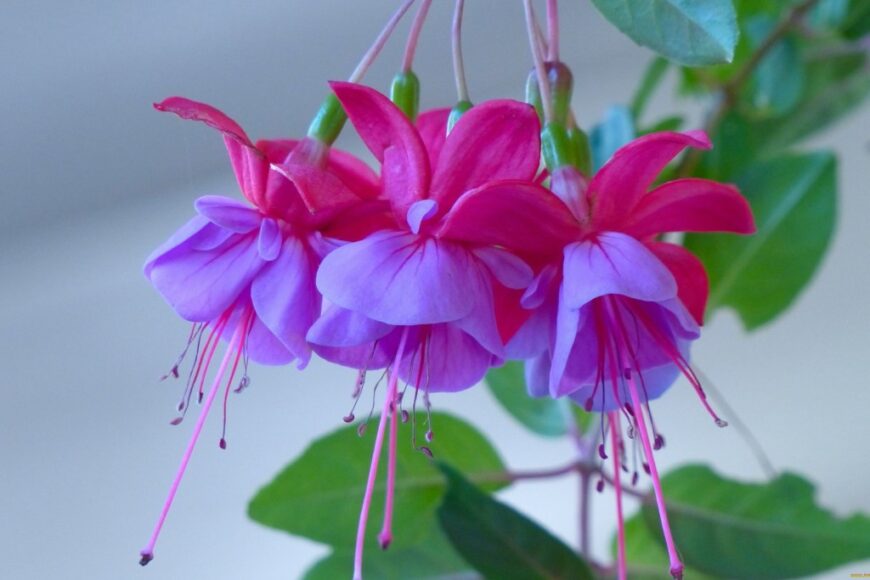
 Name: Fuchsia
Name: Fuchsia Family: Onagraceae
Family: Onagraceae Origins: Central and South America
Origins: Central and South America Humidity: Prefers high humidity levels, but can tolerate moderate humidity levels.
Humidity: Prefers high humidity levels, but can tolerate moderate humidity levels. Location: Partial shade to full shade.
Location: Partial shade to full shade. Soil: Well-drained, fertile soil with a slightly acidic to neutral pH.
Soil: Well-drained, fertile soil with a slightly acidic to neutral pH. Pests and diseases: Common pests include aphids, mealybugs, and whiteflies. Common diseases include fungal diseases, bacterial wilt, and Verticillium wilt.
Pests and diseases: Common pests include aphids, mealybugs, and whiteflies. Common diseases include fungal diseases, bacterial wilt, and Verticillium wilt. Care: Water regularly, especially during hot weather. Fertilize every 2-3 weeks with a balanced fertilizer. Deadhead spent flowers to encourage reblooming. Pinch back the tips of young plants to promote bushier growth.
Care: Water regularly, especially during hot weather. Fertilize every 2-3 weeks with a balanced fertilizer. Deadhead spent flowers to encourage reblooming. Pinch back the tips of young plants to promote bushier growth. Height of growth: Fuchsias can grow anywhere from 12 to 36 inches tall, depending on the variety.
Height of growth: Fuchsias can grow anywhere from 12 to 36 inches tall, depending on the variety. Planting in the soil: Plant fuchsias outdoors after the last frost date. Space plants 12-18 inches apart, depending on the variety. Water deeply after planting.
Planting in the soil: Plant fuchsias outdoors after the last frost date. Space plants 12-18 inches apart, depending on the variety. Water deeply after planting. Blooming: Fuchsias typically bloom from spring to fall.
Blooming: Fuchsias typically bloom from spring to fall.Fuchsia, a genus of flowering plants, is celebrated for its pendulous, tubular flowers and vibrant colors. With a diverse range of cultivars, Fuchsia offers a spectacular addition to gardens. Drawing from my extensive experience, I unravel the mysteries of successfully growing and caring for Fuchsia.
Content:
Exploring Fuchsia Varieties
Fuchsia Diversity
Fuchsia hybrids come in various forms, including upright bushes, trailing varieties, and hardy shrubs. The American Fuchsia Society notes that hybridization has led to an extensive array of flower shapes and color combinations, allowing for personalized garden aesthetics.
Hardy vs. Tender Varieties
Distinguish between hardy and tender Fuchsia varieties. While hardy ones withstand colder temperatures, tender varieties are best suited for warmer climates or as seasonal container plants.
Ideal Growing Conditions
Fuchsia thrives in partial shade, sheltered from harsh midday sun. The Royal Horticultural Society recommends well-draining, humus-rich soil for optimal growth.
Container Cultivation
For those with limited garden space, Fuchsia excels in containers. A study in the Journal of Horticultural Science found that container gardening provides better control over soil conditions, essential for Fuchsia health.
Nurturing Fuchsia: Essential Care Tips
Watering Best Practices
Fuchsia demands consistent moisture without waterlogging. Utilize a drip irrigation system or water at the base to prevent fungal issues. Research in the Journal of Experimental Botany emphasizes the importance of balanced soil moisture for Fuchsia’s water uptake.
Feeding Fuchsia
Fuchsia requires regular feeding during the growing season. A balanced liquid fertilizer, applied every two weeks, ensures a steady supply of essential nutrients. This practice supports robust flowering, as observed in studies by the American Society for Horticultural Science.
Pruning Techniques for Fuchsia
Pinching for Bushiness
Pinch out the growing tips to encourage bushier growth. This method, validated by the Journal of Plant Growth Regulation, stimulates lateral shoots, resulting in a fuller and more floriferous Fuchsia.
Deadheading for Continuous Blooms
Remove spent flowers to promote continuous blooming. The European Journal of Horticultural Science emphasizes deadheading’s positive impact on Fuchsia’s reproductive success.
Landscaping Beauty
Fuchsia’s pendulous flowers lend themselves to landscaping designs. The International Journal of Environmental Science and Development explores how Fuchsia enhances garden aesthetics and biodiversity.
Attracting Pollinators
Fuchsia’s tubular flowers attract hummingbirds and butterflies. Research in Ecology Letters highlights the vital role Fuchsia plays in pollinator-friendly landscapes.
Frequently Asked Questions (FAQs)
Can Fuchsia withstand winter?
Hardy Fuchsia varieties can survive mild winters, but most are best treated as annuals or overwintered indoors in colder climates.
How do I prevent Fuchsia diseases?
Ensure proper air circulation, avoid overhead watering, and inspect for pests regularly. Fuchsia is susceptible to rust and mites.
Can Fuchsia be grown indoors?
Absolutely! Compact and trailing Fuchsia varieties thrive in well-lit indoor spaces. Provide bright, indirect light and consistent moisture.
Do all Fuchsia varieties have the same care requirements?
No, care requirements may vary. Hardy types may tolerate cooler conditions, while tender varieties need warmer temperatures and protection from frost.
In conclusion, cultivating Fuchsia brings forth a symphony of color and elegance. This comprehensive guide equips enthusiasts with the knowledge needed to cultivate and nurture these exquisite flowering plants for a vibrant and flourishing garden.

